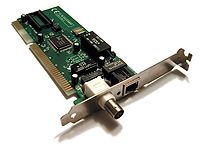Network interface controller
 A 1990s Ethernet network interface controller card which connects to the motherboard via the now-obsolete ISA bus. This combination card features both a (now obsolete) bayonet cap BNC connector (left) for use in coaxial-based 10base2 networks and an RJ-45 connector (right) for use in twisted pair-based 10baseT networks. (The ports could not be used simultaneously.) |
|
| Connects to |
Motherboard via one of: Network via one of:
|
|---|---|
| Speeds | 10 Mbit/s 100 Mbit/s 1000 Mbit/s up to 160 Gbit/s |
| Common manufacturers | Novell Intel Realtek Others |
A network interface card (NIC) is a hardware device that handles an interface to a computer network and allows a network-capable device to access that network. The NIC has a ROM chip that contains a unique number, the media access control (MAC) Address burned into it. The MAC address identifies the device uniquely on the LAN. The NIC exists on the 'Data Link Layer' (Layer 2) of the OSI model.
Contents |
Purpose
A network interface card, network adapter, network interface controller (NIC), or LAN adapter is a computer hardware component designed to allow computers to communicate over a computer network. It is both an OSI layer 1 (physical layer) and layer 2 (data link layer) device, as it provides physical access to a networking medium and provides a low-level addressing system through the use of MAC addresses. It allows users to connect to each other either by using cables or wirelessly.
Although other network technologies exist (e.g. Token Ring), Ethernet has achieved near-ubiquity since the mid-1990s. Every Ethernet network card has a unique 48-bit serial number called a MAC address, which is stored in ROM carried on the card. Every computer on an Ethernet network must have a card with a unique MAC address. Normally it is safe to assume that no two network cards will share the same address, because card vendors purchase blocks of addresses from the Institute of Electrical and Electronics Engineers (IEEE) and assign a unique address to each card at the time of manufacture.
Whereas network cards used to be expansion cards that plug into a computer bus, the low cost and ubiquity of the Ethernet standard means that most newer computers have a network interface built into the motherboard. These either have Ethernet capabilities integrated into the motherboard chipset or implemented via a low cost dedicated Ethernet chip, connected through the PCI (or the newer PCI express) bus. A separate network card is not required unless multiple interfaces are needed or some other type of network is used. Newer motherboards may even have dual network (Ethernet) interfaces built-in.
Implementation
The card implements the electronic circuitry required to communicate using a specific physical layer and data link layer standard such as Ethernet or token ring. This provides a base for a full network protocol stack, allowing communication among small groups of computers on the same LAN and large-scale network communications through routable protocols, such as IP.
There are four techniques used to transfer data, the NIC may use one or more of these techniques.
- Polling is where the microprocessor examines the status of the peripheral under program control.
- Programmed I/O is where the microprocessor alerts the designated peripheral by applying its address to the system's address bus.
- Interrupt-driven I/O is where the peripheral alerts the microprocessor that it's ready to transfer data.
- DMA is where an intelligent peripheral assumes control of the system bus to access memory directly. This removes load from the CPU but requires a separate processor on the card.
A network card typically has a RJ45, BNC, or AUI socket where the network cable is connected, and a few LEDs to inform the user of whether the network is active, and whether or not there is data being transmitted on it. Network cards are typically available in 10/100/1000 Mbit/s varieties. This means they can support a notional maximum transfer rate of 10, 100 or 1000 Megabits per second.
Sometimes the words 'controller' and 'card' are used interchangeably when talking about networking because the most common NIC is the network interface card. Although 'card' is more commonly used, it is less encompassing. The 'controller' may take the form of a network card that is installed inside a computer, or it may refer to an embedded component as part of a computer motherboard, a router, expansion card, printer interface or a USB device.
A MAC address is a 48-bit network hardware identifier that is burned into a ROM chip on the NIC to identify that device on the network. The first 24-bit field is called the Organizationally Unique Identifier (OUI) and is largely manufacturer-specific. Each OUI allows for 16,777,216 Unique NIC Addresses. Smaller manufacturers that do not have a need for over 4096 unique NIC addresses may opt to purchase an Individual Address Block (IAB) instead. An IAB consists of the 24-bit OUI plus a 12-bit extension (taken from the 'potential' NIC portion of the MAC address.)
See also
- MAC address
- TCP Offload Engine (TOE)
- Host bus adapter (HBA)
- Wireless network interface card (WNIC)
- Ethernet
- Gigabit Ethernet
- Router
- IPMP
- Adaptor